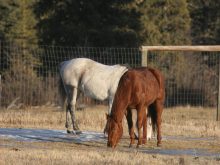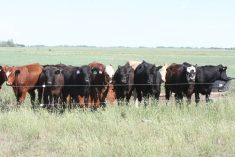Weaned calves have a lot of changes to deal with around the time of weaning.
They may be transported to an auction and then mixed with other sources of cattle into truckloads to go to a feedyard. On top of that, they are expected to adapt to a new ration and are often vaccinated and processed when they arrive at a feedlot.
In order to deal with these challenges, we often promote low-stress weaning strategies as well as appropriate vaccinations to maximize the probability of keeping these calves healthy.
Read Also

Charges laid after cattle theft
Saskatchewan RCMP lay two charges against a man after six cattle went missing.
Occasionally we can still see outbreaks of respiratory disease in calves around weaning age, despite the fact that we have attempted to prevent some of these challenges.
Trace mineral deficiencies are one possible explanation for calves not responding to vaccines appropriately. Copper and selenium are two important trace minerals that are required for optimal immune system performance.
Copper is needed for the formation of antibodies and white blood cells. It is also part of an important antioxidant enzyme known as superoxide dismutase, which is important for T-cell function, one of the important components of the immune system.
Selenium is also an important antioxidant and a component of the enzyme glutathione peroxidase, which protects a variety of cells from oxidative stress.
Several studies in Western Canada have shown that a significant proportion of our beef cow herd is deficient in copper and a smaller percentage is low in selenium. However, calves at or around the age of weaning have not received the same amount of scrutiny.
A publication in the June 2024 issue of the Canadian Veterinary Journal by Dr. Cheryl Waldner from the Western College of Veterinary Medicine’s Department of Large Animal Clinical Studies sheds some light on this important topic.
This study was part of the Canadian Cow-Calf Surveillance Network, and researchers arranged to have local veterinarians bleed approximately 20 calves per farm near the time of weaning from 106 cow-calf herds across Canada in 2021 with the co-operation of the herd owners.
Slightly less than 2,000 calves were sampled, but for the purposes of this article, we will focus on the 1,512 calves sampled from the 76 herds located in Western Canada.
The blood samples were processed at the Prairie Diagnostic Laboratory and analyzed for trace mineral content.
Slightly more than one-third (38.1 per cent) of the calves had less than adequate serum copper levels (less than 0.6 parts per million) and 17.1 per cent were deficient in their serum copper levels (less than 0.5 p.p.m.). This was by far the most common trace mineral deficiency.
However, when compared to previous studies in 2019 that examined serum copper levels in mature cows, it appeared that a lower percentage of weaned calves were suffering from copper deficiency than the cows, of which 21 per cent were classified as deficient.
The majority of farms in Western Canada (74 per cent) had at least one calf with deficient serum copper levels.
It’s important to remember that if calves are deficient in serum copper, they have probably already used up most of their liver copper stores and are truly deficient. Some of the calves with normal or less than adequate serum copper may also be close to deficient at the liver level.
These aren’t the same sampling years or identical herds, so direct comparisons between cows and calves may not be perfect. However, it does appear that copper deficiency is still a potentially significant issue in weaned calves in Western Canada, although not quite at the same level as we saw previously in mature cows.
If the deficient calves are headed to a feedyard, I would expect that their mineral levels would be corrected in due course because feeding protocols usually include adequate trace minerals in the ration.
However, it may take two to four weeks for copper levels to come back to normal, and these first few weeks are a critical time for the immune system as it prepares to defend against respiratory disease viruses and bacteria and respond to vaccines.
The true impact of low copper levels in weaned calves at the feedlot level is not fully determined.
Selenium deficiency was not nearly as common in the weaning-aged calves. Only 0.5 per cent were truly deficient, although slightly more than half the calves sampled from Western Canada (52.8 per cent) had less than adequate serum selenium.
In this case, true selenium deficiency was rare in calves at weaning age, but a significant proportion had less than adequate selenium still reported.
Having less than adequate selenium in calves could possibly take on more importance in drought conditions because vitamin E levels would also be very low, and vitamin E and selenium have a synergistic relationship when it comes to managing oxidative stress.
It perhaps isn’t surprising that we see similar trace mineral deficiencies in mature cows as we do in calves. Their trace mineral status will largely be determined by their dam’s trace mineral status, although trace minerals such as selenium may also be affected by management decisions such as injectable supplementation.
It’s important to remember that although deficiencies are common and may be associated with immune system function, we can also have major toxicity issues with copper and selenium. Too much of a good thing can be dangerous as well.
Work with a veterinarian to determine the best way to sample representative animals in your herd to assess trace mineral status before making major changes to a mineral supplementation program.
John Campbell is a professor in the department of Large Animal Clinical Sciences at the University of Saskatchewan’s Western College of Veterinary Medicine.

















